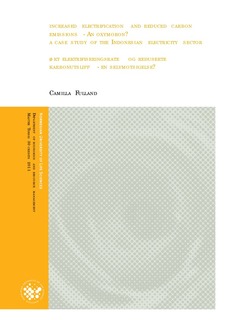| dc.contributor.author | Fulland, Camilla | |
| dc.date.accessioned | 2011-10-24T12:47:05Z | |
| dc.date.available | 2011-10-24T12:47:05Z | |
| dc.date.issued | 2011-10-24 | |
| dc.identifier.uri | http://hdl.handle.net/11250/187203 | |
| dc.description | This thesis is a contribution to the wider research project “Small is Beautiful?” which aims to identify the barriers and needed qualities of small-scale renewable energy projects in making them beneficial both for economic and environmental reasons. The project is a joint cooperation between the Department of Economics and Resource Management (IØR) at the Norwegian University of Life Sciences (UMB), the independent research agency FNI, and Differ AS, a private investment company specializing in small-scale technologies for reducing greenhouse gases. The main financer is the Norwegian Research Council. The research process included a field trip to Jakarta in March/April 2011. Two more students – Erlend Aas Guldbrandsen and Tiril Reutz – have been writing their theses’ within the same project, focusing on the Indonesian electricity sector. The research process and field trip to Indonesia have been conducted in a fruitful collaboration, while the theses’ have been written individually. All opinions expressed, and potential errors in this thesis are the responsibility of the author alone. | en_US |
| dc.description.abstract | The idea about small-scale private participants supplying green electricity to help relieve some of the capacity deficiencies of the Indonesian electricity sector seems like an optimal scenario. To achieve this outcome, the regulatory framework must provide the correct incentives, as well as being open for private participation. My thesis is an analysis of the organization of the Indonesian electricity sector following the implementation of the new electricity law in 2009, with an emphasis on private participation, as well as social and environmental issues. I evaluate the electricity sector reform and the government’s goals by investigating the incentive structures provided for various stakeholders, as well as the reform’s overall sustainability. My analysis is based on the framework of a competitive contemporary electricity sector mainly implemented in developed countries, and previous experiences of electricity sector reform in Argentina, India, and South Africa. I also analyze previous reforms in Indonesia, as these may affect the current reform and its sustainability.
The recent electricity sector reform in Indonesia is another attempt at improving the conditions of the electricity sector. Partial liberalization of the sector through the opening of the end-user market to private participation, as well as reduced transaction costs for power purchase agreements with PLN may stimulate private participation. Moreover, specific regulations creating positive incentives for increased use of renewable energy sources have been included to a much larger extent than in previous reform attempts. Main barriers for a complete reform of the electricity sector are identified as the constitutional protection of PLN, as well as the electricity tariff system. The social tariffs create disincentives for private participation which makes the participation of small-scale renewable electricity producers for rural electrification highly unlikely. Furthermore, PLN may end up with more financial troubles due to their obligation to ensure social benefits through electrification, as well as being obliged to purchase electricity from renewable energy sources. Cross-subsidizing is shown to create incentives for cream-skimming by IPPs, which may increase PLN’s subsidy need. Moreover, a non-specific subsidy to PLN may increase the use of coal for electricity generation under the current regulatory framework.
Due to conflicts in the government’s goals, the recent reform seems unsustainable in its current form. The current regulations may lead to increased use of renewable electricity sources for electricity generation and electrification, but it may also lead to an increased use of coal. Consequently, it is still uncertain if the combination of increased electrification and reduced carbon emissions will remain an oxymoron in Indonesia’s electricity sector. | en_US |
| dc.description.sponsorship | Norwegian Research Council, Differ AS, FNI, UMB | en_US |
| dc.language.iso | eng | en_US |
| dc.subject | electricity sector | en_US |
| dc.subject | renewable energy | en_US |
| dc.subject | Indonesia | en_US |
| dc.subject | developing countries | en_US |
| dc.subject | small-scale electricity generation | en_US |
| dc.subject | electrification | en_US |
| dc.title | Increased electrification and reduced carbon emissions : an oxymoron? A case study of the Indonesian Electricity Sector | en_US |
| dc.title.alternative | Økt elektrifiseringsrate og reduserte karbonutslipp - en selvmotsigelse? | en_US |
| dc.type | Master thesis | en_US |
| dc.subject.nsi | VDP::Technology: 500::Electrotechnical disciplines: 540::Electrical power engineering: 542 | en_US |
| dc.subject.nsi | VDP::Social science: 200::Political science and organizational theory: 240 | en_US |
| dc.source.pagenumber | 105 | en_US |
